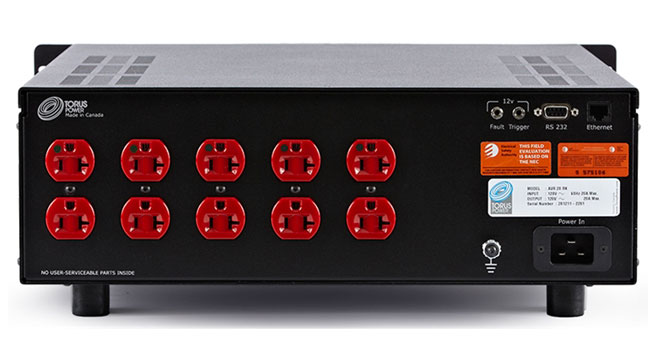Torus AVR 20 AC Conditioner

 There are many types of AC line enhancers available today. However, I haven’t been using any of them in last few years. I’ve had plenty of AC line enhancers over the years but only a few have provided the promised improvements. This might sound illogical, but about five years ago I compared a power conditioner with my components going directly into the AC wall outlets with an upgraded duplex wall receptacle and, believe it or not I was shocked to find out that plugging components straight into a wall outlet sounded better in my system. The only the problem I had with the AC wall outlets were that I needed more receptacles to plug in my reference system. So, I made myself a DIY Oyaide power distributor MT-UB with 2 Afterburner 8 wall outlets (which, by the way are same model I changed my wall outlets with).
There are many types of AC line enhancers available today. However, I haven’t been using any of them in last few years. I’ve had plenty of AC line enhancers over the years but only a few have provided the promised improvements. This might sound illogical, but about five years ago I compared a power conditioner with my components going directly into the AC wall outlets with an upgraded duplex wall receptacle and, believe it or not I was shocked to find out that plugging components straight into a wall outlet sounded better in my system. The only the problem I had with the AC wall outlets were that I needed more receptacles to plug in my reference system. So, I made myself a DIY Oyaide power distributor MT-UB with 2 Afterburner 8 wall outlets (which, by the way are same model I changed my wall outlets with).
Don’t get me wrong, my system sounded good with the power conditioner, but without it was a touch better in some areas. How could this be possible? I’m living in a high-rise apartment in Manhattan sharing dirty power lines with my next-door neighbors; they use blow driers, refrigerators, computers and even air conditioners, so how this could be? I’m not saying to dismiss all AC power conditioning products. Every component behaves differently, and I call it a synergy. My former long-time reference Karan KSA 450 power amplifier and the AMR CD77 CD player simply sounded better plugged straight into a wall. Nor did plugging my components directly curtail current flow and/or dynamics. In fact, a few designers whom I trust, told me that their component’s power supply was designed around AC conditioners and they felt they could potentially do more harm than good. I think they were right. Some highly touted AC conditioners I’ve tried either limited current, stripped harmonics and in some cases, both. In the end, I sold my AC conditioner and put the money into other areas of my audio system.
A lot has changed in the past five years. I was talking with a colleague at the beginning of the year and I was informed he was so impressed with a newest AC power conditioner that he recently reviewed. He suggested to me that I should definitely give a listen to newer AC power conditioners as well. In fact, everyone I talked with and trusted recommended that I try one. There are a lot of AC line enhancers out on the market nowadays and trying to find the right one without the similar past experiences had me worried. However, I was a very curious about the Torus Power isolation transformer, which a few colleagues had recommended. I contacted Dale Shultz, a Torus Power representative, and I told him I would like to review the Torus Power. Shultz told me that he would get one ready and send it out for potential review (first, I had to give it a listen and confirm that it could perform as suggested).

Torus Power isolation transformers are engineered and manufactured by Plitron, the world’s leading innovators in toroidal transformer technology. The AVR 20 combines surge suppression with a massive toroidal isolation transformer to provide AC power conditioning and automatic voltage regulation (AVR). In addition, the AVR20’s standard features also include protection against voltage sags, brownouts, and surges while it maintains a constant output within the range of 115 Volts to 125 Volts, with an input Voltage of 90V to 130V. The AVR 20 restores incoming power to its clean original state using Plitron’s narrow bandwidth technology (NBT) and allowing the transformer to act as a very effective low-pass filter. Torus states, “The corner frequency for noise attenuation is 2 kHz with an attenuation rate of 12dB/decade to 500 kHz. Another important advantage of NBT technology is the elimination of external filters, such as capacitors, and other components that can fail over time.” The AVR 20 is equipped with a single 2400VA toroidal isolation transformer to supply 120V and 20A to ten Hubbell hospital grade AC outlets located on the rear.
One sunny afternoon a big box on a pallet was delivered to my apartment. This is the first time that I recall a package coming on a pallet. I managed to muscle the Torus Power AVR 20 onto a dolly, but boy was it heavy. Finally, I got it up to my apartment and it wasn’t an easy job to take the AVR 20 out of the box and set it up. Weighing in at 95 lbs makes it easily a 2 people job (Be sure to find someone to help as I almost blew my back out). My review sample came in black but the AVR 20 is also available in silver. The design is utilitarian but it does feature cool LED readouts on its front panel which monitor voltage level and displays output current.
In my high-rise apartment the input voltage was a steady 118V and output voltage was 122V. Fortunately, I was told that my review unit didn’t require any burn-in time so I just let the AVR 20 settle in for couple of days before any serious listening was done. I placed the Torus Power in my reference system, which for a while now has been comprised of the Thrax Teres Hybid monoblock amplifier, Decware ZMA amplifier, a Thrax Dionyosis preamplifier, Thrax Orpheus phonostage, Musical Life Symphony II turntable and Musical Life Vocalista tonearm with Lyra Klios cartridge. My source components are currently the Pi Greco Symphonia CD player and Meitner CD player while my long-standing reference loudspeakers are Consensus Audio Engineering Conspiracy loudspeakers. The superb sounding EnKlein David cables were utilized throughout the system along with equally impressive Hemingway cables.
 I was quite excited, I must admit, to finally listen to my system with an AC conditioner once again. But I was forewarned the Torus AVR 20 was not just any AC conditioner. And once I inserted the Torus Power immediately captured my attention. I put on one of my favorite LP’s in Melody Gardot’s The Rain from “My One and Only Thrill” (Verve) and instantly I heard a difference. First thing I noticed was a jet-black background unlike any I have experienced in the past. This allowed me to I hear and connect to the music even more deeply. Definition, detail and image specificity improved as well. The soundstage was remarkably well-focused and stable, with more ambient space between the notes and musicians. Melody Gardot’s sensual voice felt more tangible and real. Her gestures possessed more texture and authenticity. In essence, the music had more ebb and flow. I said to self “Calm down. Let’s not get too excited!”
I was quite excited, I must admit, to finally listen to my system with an AC conditioner once again. But I was forewarned the Torus AVR 20 was not just any AC conditioner. And once I inserted the Torus Power immediately captured my attention. I put on one of my favorite LP’s in Melody Gardot’s The Rain from “My One and Only Thrill” (Verve) and instantly I heard a difference. First thing I noticed was a jet-black background unlike any I have experienced in the past. This allowed me to I hear and connect to the music even more deeply. Definition, detail and image specificity improved as well. The soundstage was remarkably well-focused and stable, with more ambient space between the notes and musicians. Melody Gardot’s sensual voice felt more tangible and real. Her gestures possessed more texture and authenticity. In essence, the music had more ebb and flow. I said to self “Calm down. Let’s not get too excited!”
CD after CD was followed by LP after LP. Consistently, no matter the type of music, my system sounded so much quieter, cleaner and ultimately better with the AVR 20 installed in it. There were quieter backgrounds and inter-transient silences; they were rendered in a more relaxed way with all of the components I tried. I put on Dvorak’s Symphony N0.9 in E minor, Op.95 (JMCXR-0013) “From the New World” by the maestro, Fritz Reiner conducting the Chicago Symphony Orchestra. Both the soundstage and the sense of space were outstanding. I prefer an enormous size and scale on a soundstage and the Torus Power provided one which was more three-dimensional and picturesque. The orchestral crescendos are rendered with great control and authority from pianissimo to fortissimo. The system handled it all with great realism without limiting its dynamic range capability while the power, weight and slam of the orchestra proved really impressive. More importantly, the portrayal of individual images was exceptional, revealing layers of small details and nuances that I’d not previously heard. Sounds like an improvement across the board, right? It certainly does.
The Torus Power AVR 200 is an exceptional power conditioner. I was pleased to note that for the first time my reference system’s overall sound had improved without limiting its dynamic range, something not all power conditioners can make claim of. This was not a case of an AC power conditioner trade offs. I haven’t heard all the new power conditioners out there but now that I have experienced the Torus AVR 20 in my system, one thing I can say for certain is THIS IS A KEEPER! Highly recommended!


key kim
Specifications:
Price: $4995.00
Output Current: 20A
Nominal Output Power VA: 2400
Input Voltage VAC: 85VAC to 135VAC
Output Voltage VAC: 120VAC ± 5V (115V to 125V)
Nominal Input Current IAC: 20
Triggers: 2 X 12 Volt
Max. Output Current: 20 A
No. of Outlets: 10 (5 x 2)
Output Connector Type: Medical Grade – Duplex
Line Cord: IEC C195-15, 5-20p, Straight Blade, 2 Pole, 3 Wire Grounding, 20A, 125V
Output Connector Rating: 20A
Weight: 95 lbs.
Dimensions: 22″ x 19″ x 5.47″
Website: www.toruspower.com/
Stereo Times Masthead
Publisher/Founder
Clement Perry
Editor
Dave Thomas
Senior Editors
Frank Alles, Mike Girardi, Russell Lichter, Terry London, Moreno Mitchell, Paul Szabady, Bill Wells, Mike Wright, and Stephen Yan,
Current Contributors
David Abramson, Tim Barrall, Dave Allison, Ron Cook, Lewis Dardick, John Hoffman, Dan Secula, Don Shaulis, Greg Simmons, Eric Teh, Greg Voth, Richard Willie, Ed Van Winkle, Rob Dockery, Richard Doran, and Daveed Turek
Site Management Clement Perry
Ad Designer: Martin Perry





Be the first to comment on: Torus AVR 20 AC Conditioner